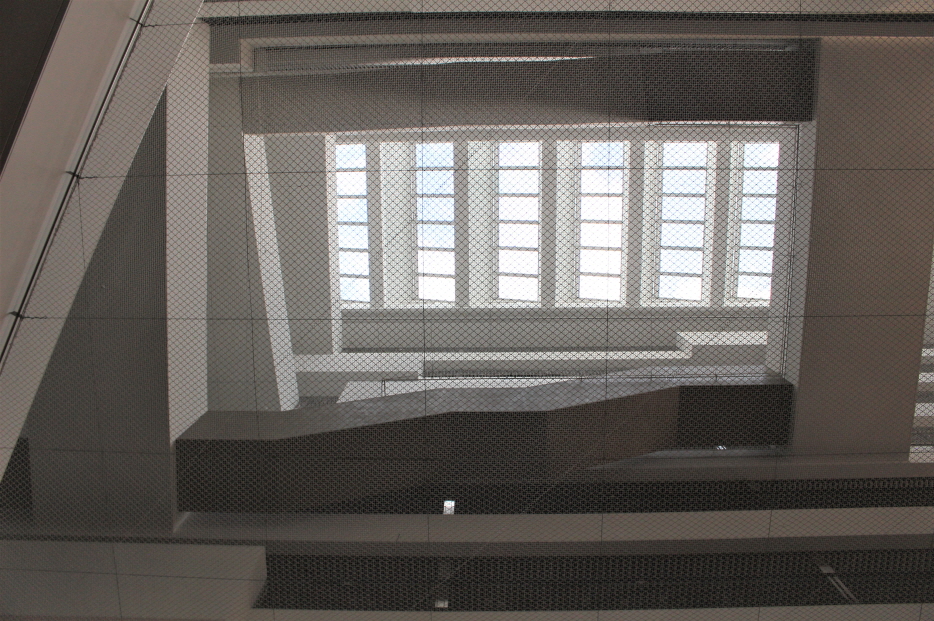Have you ever taken a class in Building 310? Many students probably have, but even if you have not, you will at least know this much about Building 310: it is very big with many lecture rooms and other new and attractive facilities. While the aesthetic value of Building 310 is widely accepted, it is also important to consider the practical value of the building. Unfortunately, the current state of Building 310 is not practical for students, who can easily feel confused when they are left wandering around the building, searching for the place they are trying get to. This problem needs to be improved as soon as possible so that Building 310 can be well-utilized and convenient for students.
The Symmetrical Structure on the Ground Floor of Building 310
Building 310 is a very large building that can be broadly classified into two levels: ground and underground. The ground floor, located in the center of the building, is completely open, allowing the roof of the upper floor to be seen from the first floor. The corridors and lecture rooms are composed of hollow cylindrical structures. The design is beautiful, but when students and visitors need to go to a classroom or office, this structural attraction can become a great confusion. The top floor of Building 310, which consists of a cylindrical structure with a break rather than a simple hollow cylinder, is no different when it comes to its functionality: students often end up in a dead end while trying to find a classroom.
The Omission of Several Rooms on the Sign
Even though the structure of the building creates confusion among students and visitors, one might assume that signs indicating the direction of classrooms can help them find their way. This is sometimes the case, but, then again, not always. Some classrooms are unfortunately missing signs, and multi-purpose rooms, such as team rooms and seminar rooms, are often omitted from the sign boards that have been installed on the ceiling where elevators are located and lecture rooms in the same direction are tied up. In short, while it is possible to find regular classrooms, other places in Building 310 can be very hard to locate due to the building’s ineffective signs. In the picture on the left, you can check out 12 club rooms. However, if you look at the guide boards of the two pictures on the right, you can see that there is no explanation for the club room.
The Mix of Parking Lots and Buildings
As discussed above, Building 310 is divided into ground and underground. This leaves the basement, which contains both parking lots and spaces for general use. Since the basement has spaces for parking lots and spaces for general use coexisting on the same floor, it is possible to get out of an elevator and suddenly find yourself in a parking lot. This is a problem because finding your way from a parking lot back to a public space can be difficult. As you can see from the picture next to it, there are no signboards for the general building. A similar problem was experienced at Ewha Women's University, which built Ewha Campus Complex (ECC) to solve chronic student acceptance problems. While many aspects of ECC are similar to Building 310 at Chung-ang University, particularly in terms of their large size, Ewha Women’s University has reduced the confusion of students by moving underground parking into the two lowest floors. Chung-Ang University needs to consider taking similar steps to solving the problems created by the layout of Building 310’s basement floor.
Another name for the building 310 is the 100th Anniversary Memorial Hall. Since it is the largest building on campus and carries the symbolic name of 'the 100th Memorial Hall', Building 310 has always served as a campus landmark ever since it was established. However, if the building’s value remains mostly aesthetic and it continues to underserve its practical value, Building 310 will not create a good understanding among students or visitors. Therefore, Chung-ang University should change the sign system at the building so that it is more intuitive for people to get to where they are going. Adding the missing signs of classrooms and multi-purpose rooms would be a good place to start. When Building 310 is capable of living up to both its practical and aesthetic values, it will show real dignity as a landmark of the Chung-ang University and increase student's pride.


